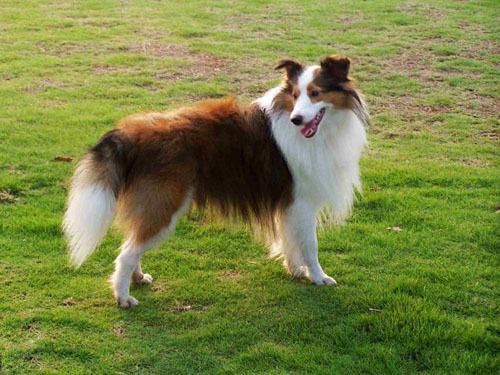Sheltie
IUCN
LCBasic Information
Feature
Ranked sixth in the world's dog intelligence rankings
Distribution and Habitat
Mainly distributed in the UK and North America
Appearance
The Shetland Sheepdog is 33-41 cm tall and weighs 6-7 kg. The body length is slightly greater than the height. The head is long and blunt wedge-shaped, tapering from the ears to the nose. The eyes are medium-sized, dark in color, almond-shaped, and slightly slanted. The ears are relatively small and flexible, set high, 3/4 erect, with the tip folded forward. The color must be dark black, except for the sapphire eyes, which can be blue or sapphire. The muzzle is round, the length is equal to the length of the skull, and the intersection is at the inner corner of the eye. The lower jaw is deep and well-developed, extending to the nostrils, and the nose must be black. The teeth are scissor-like. The neck is muscular, arched, and of sufficient length to allow the head to be held proudly. The back is level and muscular. The chest is deep and extends to the elbows. The ribs are well sprung and the abdomen is moderately tucked up. The loin is slightly arched, and the hips gradually slope back
Details
The Shetland Sheepdog, also known as the Shetland Sheepdog, is a small breed of Collie, well-proportioned and beautiful, and can be easily mistaken for a rough-haired sheepdog. The ancestors of the Shetland Sheepdog are sheepdog breeds, so they can become excellent family dogs and clever guard dogs.

For centuries, this dog has been used to herd sheep and guard on the Shetland Islands, which are rocky islands off the coast of Scotland. The animals on the islands are all small. In 1908, the Shetland Island first established a club, and the following year Scotland also established a Shetland Club. It was introduced to England in the late 19th century. After being introduced to the United States in 1911, it was very popular and now the dog has spread all over the world. The first Shetland Sheepdog registered with the AKC was Lord Scott, a dark sable sheepdog from the Shetland Islands in Scotland, registered in 1911. His owner was John G. Sherman, Jr. from New York. After arriving in the United States, ranches and farms became the new home of the Shetland Sheepdog. No matter where in the United States, it is an indispensable and important role in the family and work.
Shetland Sheepdogs are very smart, lively and adaptable. They are loyal and enthusiastic to their owners. They are naturally happy to be with their owners, but they are very vigilant and alert to strangers.
No matter what kind of dog it is, body odor is always inevitable, and some body odors are so strong that people can't stand it. But Shetland Sheepdogs have very little body odor, and they like to be clean, and they won't get dirty like other dogs.








